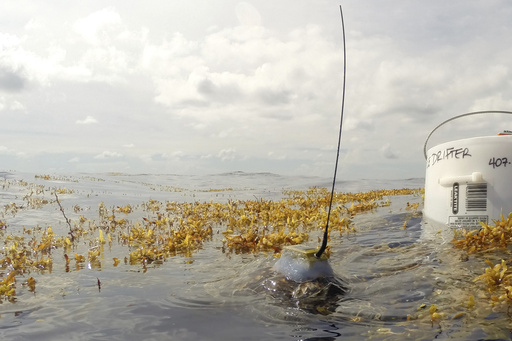
WASHINGTON — Researchers utilizing satellite tracking have managed to locate young sea turtles during a significant phase of their development.
“We’ve encountered considerable gaps in our understanding of the early growth stages of sea turtles, from hatchlings to juveniles,” stated Kate Mansfield, a marine scientist at the University of Central Florida. “This interval of their extensive lifespan has largely remained elusive.”
For many years, scientists have been curious about the happenings during the so-called “lost years” — the period when tiny hatchlings depart the beach and do not return until nearly fully grown, spanning approximately one to ten years.
New research released on Tuesday offers insights that begin to clarify this enigmatic period.
Over the course of more than ten years, Mansfield and her team affixed GPS tags to the rapidly growing shells of young wild turtles. Using small boats, they navigated through the Gulf of Mexico searching for these young turtles among the drifting algae, successfully tagging 114 turtles, including endangered species like green turtles, loggerheads, hawksbills, and Kemp’s ridleys.
Eventually, the GPS tags would shed off due to the rapid growth of the turtles; “As young turtles grow, the outer layer of their shells naturally sheds,” explained Katrina Phillips, a marine ecologist at the University of Central Florida and co-author of the study, which was published in the Proceedings of the Royal Society B.
Although the tags didn’t remain on for an extended period, they transmitted location data for several weeks to a couple of months. The findings from this research contradicted many preconceived notions regarding the behaviors of these young reptiles.
Traditionally, scientists believed that these tiny turtles merely drifted along with ocean currents, passively going where the water took them.
“Our research reveals that the turtles are actively swimming,” noted co-author Nathan Putman, an ecologist from LGL Ecological Research Associates in Texas.
The team confirmed this by comparing the tracking data of the young turtles with the paths taken by drifting buoys placed in the same waters. Interestingly, over half of the buoys washed ashore, while the turtles remained in open water.
“What we discovered is that these small hatchlings are actively making choices about their movements and what they choose to steer clear of in the ocean,” added Bryan Wallace, a wildlife ecologist at Ecolibrium in Colorado.
The tracking data also revealed unexpected variability in the turtles’ locations, showing movement between coastal shelf waters and the open sea.
A significant challenge involved both locating the turtles and creating adaptable solar-powered tags sufficient to remain on the turtles’ shells long enough to retransmit valuable data.
“For a long time, the technology could not meet our expectations,” remarked Jeffrey Seminoff, a marine biologist at NOAA who was not part of this study.
These findings enrich biologists’ understanding of how juvenile turtles utilize the Gulf of Mexico, an essential habitat for four endangered sea turtle species.
“It’s not that sea turtles were ever lost; rather, we had lost sight of them,” concluded Jeanette Wyneken from Florida Atlantic University, who did not contribute to the research.

